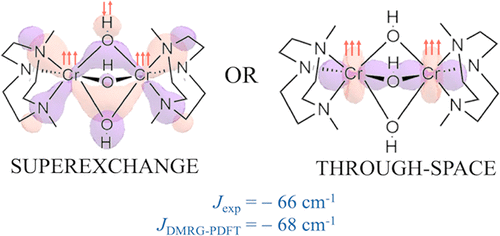当前位置:
X-MOL 学术
›
J. Am. Chem. Soc.
›
论文详情
Our official English website, www.x-mol.net, welcomes your
feedback! (Note: you will need to create a separate account there.)
Magnetic Coupling in a Tris-hydroxo-bridged Chromium Dimer Occurs Through Ligand Mediated Superexchange in Conjunction with Through- Space Coupling
Journal of the American Chemical Society ( IF 14.4 ) Pub Date : 2020-09-02 , DOI: 10.1021/jacs.0c06399 Prachi Sharma 1 , Donald G Truhlar 1 , Laura Gagliardi 1
Journal of the American Chemical Society ( IF 14.4 ) Pub Date : 2020-09-02 , DOI: 10.1021/jacs.0c06399 Prachi Sharma 1 , Donald G Truhlar 1 , Laura Gagliardi 1
Affiliation

|
Quantum chemistry can explain and predict many properties of molecules and materials. However there are some systems, among which are magnetic systems, that remain a challenge for all electronic structure methods. The tris-hydroxo-bridged chromium dimer, known as Kremer's dimer, contains two antiferromagnetically coupled chromium (III) metal ions and provides a classic example of a magnetic molecular system that poses a challenge for computational quantum chemistry. In this study we show that combining multiconfiguration pair-density functional theory with large-active-space density matrix renormalization group wave functions can predict the correct spin-state ordering, energy spacing, and magnetic coupling constant. We also use the unpaired spin density to analyze the superexchange contribution. This methodology offers promise for revolutionary rational design of molecular magnets.
中文翻译:

三羟基桥连铬二聚体中的磁耦合通过配体介导的超交换与空间耦合发生
量子化学可以解释和预测分子和材料的许多特性。然而,有一些系统,其中包括磁性系统,仍然是所有电子结构方法的挑战。三羟基桥连铬二聚体,称为克雷默二聚体,包含两个反铁磁耦合的铬 (III) 金属离子,是磁性分子系统的一个经典例子,对计算量子化学提出了挑战。在这项研究中,我们表明将多配置对密度泛函理论与大活性空间密度矩阵重整化群波函数相结合,可以预测正确的自旋态排序、能量间隔和磁耦合常数。我们还使用未配对的自旋密度来分析超交换贡献。
更新日期:2020-09-02
中文翻译:

三羟基桥连铬二聚体中的磁耦合通过配体介导的超交换与空间耦合发生
量子化学可以解释和预测分子和材料的许多特性。然而,有一些系统,其中包括磁性系统,仍然是所有电子结构方法的挑战。三羟基桥连铬二聚体,称为克雷默二聚体,包含两个反铁磁耦合的铬 (III) 金属离子,是磁性分子系统的一个经典例子,对计算量子化学提出了挑战。在这项研究中,我们表明将多配置对密度泛函理论与大活性空间密度矩阵重整化群波函数相结合,可以预测正确的自旋态排序、能量间隔和磁耦合常数。我们还使用未配对的自旋密度来分析超交换贡献。









































 京公网安备 11010802027423号
京公网安备 11010802027423号